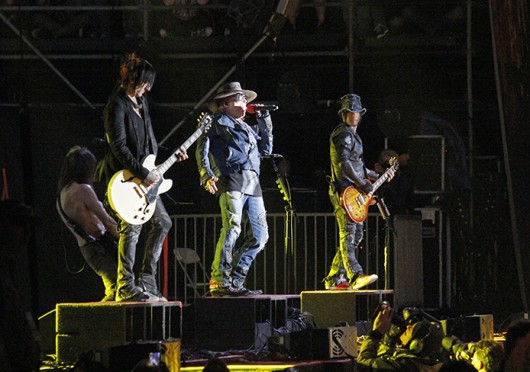
Guns N’ Roses performs at Rock on the Range on May 16 at Columbus Crew Stadium.
Credit: Jon McAllister / Asst. photo editor
“Where do we go now?”
This final question in “Sweet Child O’ Mine” ends one of Guns N’ Roses’ most iconic songs. Legend has it the song was destined to have an instrumental breakdown at its close, but the lyrical component caused lead singer Axl Rose to draw a loss. Thus was born the permanence of the improvisational line.
Historically, Rose means the question quite literally in terms of the progression of the song.
Fast forward to Friday night when the rock band performed as the headliner of the headliners for Columbus’ annual music festival, Rock on the Range, and the audience took the question rhetorically.
Upon the final note of “Sweet Child O’ Mine,” which was performed at the halfway point of GNR’s roughly 30-song set, the sold-out crowd at Columbus Crew Stadium knew exactly where to go — back to their cars, homebound.
Of course, those folks were likely caught in traffic, stuck with the people who quickly bid adieu after being welcomed to the jungle about 14 songs ago.
What was left of the audience, a fraction of the originally sizeable crowd, was likely waiting on “Paradise City” before making their getaway. What they didn’t know, however, was the last song of the GNR trifecta was only earned after listening to the rest of the band’s underwhelming, tedious and colorless performance as well as its five-song encore.
After that, “Oh won’t you please take me home” wasn’t so much of a request in an audience member’s mind as it was a fatigued demand.
Admittedly, I deem Guns N’ Roses’ Rock on the Range performance in this way with a heavy heart.
The Los Angeles-based band, which arguably experienced its heyday in the late ‘80s and early ‘90s, is one I find an important fixture in the history of classic, no-frills rock. I consider “Appetite for Destruction” a masterpiece worthy of the high praise with which all teenage boys regard Slash’s pentatonic phrases and Duff McKagan’s funk-infused bass lines. Also, I find the pack-a-day scratchiness of Rose’s voice not the least bit irritating, but a testament of his range and vocal control.
You could call me a Guns N’ Roses purist, though, as I am most fond of the band’s original lineup and everything pre- “Chinese Democracy.” I expressed this sentiment in a Lantern opinion piece in January, when ROTR announced its lineup and the imminent GNR performance. By the way of a snarky narrative, I argued that although GNR is set to take the Columbus Crew stage, it’s not really GNR who is in attendance with the absence of Slash, McKagan, Izzy Stradlin and Steven Adler.
My point was genuine, but doused with the hope of being proved wrong upon seeing the band’s performance at ROTR.
Unfortunately, I was right. And bored. Very bored.
With that being said, I would be amiss to claim GNR sounded terrible in its performance. The lineup, which included Rose on lead vocals, Dizzy Reed on keys, DJ Ashba and Ron “Bumblefoot” Thal on guitar, Tommy Stinson on bass and Frank Ferrer on drums, is full of talented musicians more than capable of decently emulating the band’s catalogue as well as covers of other class acts, including Led Zeppelin, Sex Pistols, The Who and New York Dolls. From “Mr. Brownstone” to “November Rain,” “Holidays in the Sun” to “The Seeker,” musically, everything resonated as technically correct.
However, musical technicality can be rendered by listening to the band’s album and is only valued in the beginning stages of musicianship. GNR is considered a master of more than 25 years with a history of impassioned, non-apologetic, rough-around-the-edges performances.
Between pyrotechnics on random downbeats, confused graphics and an opaque fourth wall between the band and the audience, what Friday night’s crowd experienced was a wimpy, disengaged routine.
If choosing to experience Guns N’ Roses live in 2014, it is best to “use your illusion” to imagine the band’s pinnacle.


